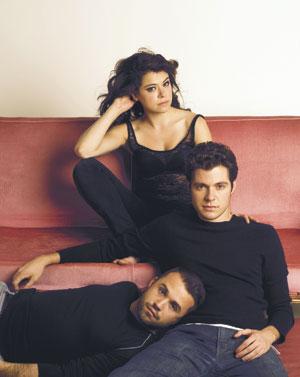Consider for a moment the world in December 1997. Pagers were the hot new accessories. Television producers still shied away from taboo topics; neither Sex and the City nor Will & Grace had hit the airwaves. Bill Clinton’s impeachment was but a glint in Newt Gingrich’s eye. Hijacked planes destroying New York office towers seemed as implausible as America electing a black president. This is the backdrop for Other People, Christopher Shinn’s sexually charged drama about ambitious young artists in the Big Apple.
Connecting with this history was key for Indrit Kasapi and the collective of artists giving the show its Toronto premiere.
“We spent a lot of time examining late-’90s culture to understand the characters’ mindset,” he says. “Communication is becoming harder today because of technology, but you can see the roots of that in the world of this play. At the core is a group of people who aren’t able to express how they feel, which makes it particularly relevant at this moment in time.”
Stephen (Ben Lewis), a failed actor and struggling playwright, invites his ex-boyfriend Mark (Kasapi) to spend Christmas with him and his roommate Petra (Tatiana Maslany), a fledgling poet and part-time stripper.
Mark was a budding filmmaker in Los Angeles, but an emotional breakdown landed him in rehab. There he became a born-again Christian, which leads to a struggle with his sexuality. In a tiny East Village flat, the trio talk sex and art and try to imagine their futures as the new year dawns. Though the description conjures bad Fringe Festival plays in which a group of artists sit around, bitching about the challenge of being artists, Kasapi stresses the show is anything but.
“We were aware of falling into that trap, so we spent a lot of time looking at what’s going on behind the words,” he says.
Kasapi had much to draw from in connecting with his character’s experience. After his family left Albania for Toronto when he was 15, they converted to Catholicism, an event that contributed to his own struggle around sexuality, much like his character in the show.
He had studied dance back home but felt he didn’t have the chops for it and opted to pursue acting instead. After graduating from the National Theatre School in Montreal in 2006, he returned to Toronto and began etching out a career. Though he’d long since come out to himself, his family was kept deliberately in the dark, a challenging thing since his growing resumé was largely queer, including Jean Genet’s gay prison drama Deathwatch.
The gay bent of his career wasn’t intentional; it was simply a product of the roles he secured. But it wasn’t until he took part in last summer’s Still Life, a semi-autobiographical project produced with Toronto collective lemonTree theatre creations, that he decided to come out to his family. His character lived with his boyfriend but wasn’t able to come out to his parents.
“We were improvising a scene where he tells me I need to come out, and I realized in that moment I didn’t have any more arguments for not being honest with my family,” Kasapi says. “In the end, I was shocked by how minimal their reaction was. I consider myself lucky. The time before I came out seems like another reality. But given the number of closeted characters that are written, I’ll probably get to draw on it over and over.”


 Why you can trust Xtra
Why you can trust Xtra


